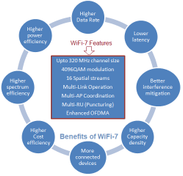Carrier Frequency Offset and Timing Drift in WiFi-7
Advertisement
In Wi-Fi 7 (IEEE 802.11be), carrier frequency offset (CFO) error and timing drift are critical factors that can impact the synchronization between transmitters and receivers, leading to performance degradation if not properly managed. These parameters ensure that devices can accurately align their signals in terms of frequency and time, which is essential for maintaining reliable and efficient communication in wireless networks.
Carrier Frequency Offset (CFO) Error
Carrier frequency offset (CFO) refers to the difference between the actual carrier frequency of a transmitted signal and the expected or nominal carrier frequency at the receiver. This offset can occur due to imperfections in the oscillators used in both the transmitter and receiver, and it can lead to errors in signal demodulation.
Key Points of CFO Error
-
Definition: CFO error is the deviation of the received carrier frequency from the expected frequency. It results from differences between the transmitter’s and receiver’s local oscillators, which can be caused by factors like oscillator inaccuracies, temperature variations, and Doppler shifts.
-
Impact of CFO:
-
Interference and Symbol Misalignment: CFO can cause inter-carrier interference (ICI) in OFDM systems, where subcarriers are no longer orthogonal, leading to degradation in signal quality and increased error rates.
-
Phase Rotation: A frequency offset introduces a phase rotation across the symbols, which can complicate the demodulation process.
-
Requirements in Wi-Fi 7
-
Wi-Fi 7 specifies stringent requirements for CFO to ensure minimal impact on signal demodulation. Typically, the CFO should be controlled within a small fraction of the subcarrier spacing (e.g., within +/- 20 ppm for the local oscillators).
-
CFO Correction: Receivers must be able to estimate and correct the CFO to align the carrier frequency with the incoming signal, maintaining synchronization.
-
For the CFO requirement, the CFO error statistics are measured. At the 10 % point of the CCDF curve, the CFO error must be less than 350 Hz. The measurement is made in the primary 20 MHz channel at –60 dBm received power. The CFO is measured after the U-SIG field on an EHT TB PPDU.
CFO Estimation and Correction
-
Pilot Signals: Wi-Fi 7 uses pilot signals embedded in the OFDM symbols to estimate CFO. By comparing the received pilot tones to the expected positions, the receiver can estimate the CFO and apply a correction.
-
Tracking: Continuous tracking algorithms adjust the frequency synchronization over time to account for changes in CFO due to factors like temperature drift or movement.
Timing Drift
Timing Drift refers to the deviation of the signal timing between the transmitter and receiver, which can occur due to clock inaccuracies, varying propagation delays, or environmental changes.
Key Points of Timing Drift
-
Definition: Timing drift is the gradual misalignment of timing between the transmitter and receiver clocks. It can result from small differences in the clock rates or environmental influences such as temperature changes.
-
Impact of Timing Drift:
-
Symbol Timing Errors: Timing drift can cause symbols to overlap or be misaligned, leading to increased inter-symbol interference (ISI) and errors in decoding.
-
Guard Interval and OFDM Symbols: In OFDM systems, timing drift can lead to errors if the drift exceeds the guard interval, causing the symbols to interfere with each other.
-
Requirements in Wi-Fi 7
-
Timing Synchronization: Wi-Fi 7 requires that timing drift be kept within acceptable limits to ensure proper symbol alignment. This involves maintaining tight control over the synchronization of the receiver clock relative to the transmitted signal.
-
Error Tolerance: Typically, the timing error must be significantly less than the symbol duration to avoid substantial performance degradation. Wi-Fi 7 specifications aim for timing errors that remain within fractions of a symbol period.
-
At the STA antenna connector, the accuracy of this time is required to be +/- 0.4 µs + 16 µs from the end of the last OFDM symbol of the triggering PPDU sent by the AP to trigger the UL transmissions.
Timing Drift Correction
-
Timing Synchronization Techniques: Receivers use preambles and pilot signals to synchronize timing with the incoming signal. Fine-tuning is performed using techniques like early-late gate algorithms or phase-locked loops (PLLs).
-
Continuous Adjustment: Receivers constantly adjust their internal timing based on the incoming signal to mitigate the effects of timing drift, ensuring symbols are correctly aligned for demodulation.
Combined Effects of CFO and Timing Drift
-
Synchronization Challenges: Both CFO and timing drift contribute to synchronization challenges in Wi-Fi 7 systems. Accurate synchronization is crucial for maintaining orthogonality between subcarriers in OFDM, which directly impacts data throughput and error rates.
-
Adaptive Correction: Wi-Fi 7 employs adaptive correction algorithms to continuously monitor and adjust for CFO and timing drift, leveraging pilot symbols and advanced signal processing techniques.
Summary
-
Carrier Frequency Offset (CFO) Error: Represents the deviation between the actual and expected carrier frequencies, which can cause phase rotation and inter-carrier interference in OFDM systems. Wi-Fi 7 devices use pilot tones and correction algorithms to estimate and mitigate CFO.
-
Timing Drift: Refers to the misalignment of timing between the transmitter and receiver, leading to symbol overlap and increased inter-symbol interference. Wi-Fi 7 manages timing drift through precise synchronization techniques, ensuring symbols are correctly aligned.
-
Managing CFO error and timing drift is critical for the high performance of Wi-Fi 7, allowing devices to maintain reliable, high-speed connections in complex and variable wireless environments.
Advertisement
 RF
RF


